Question
Subject: Solid Douglas Fir exterior door.
Problem: Homeowner installed a new unfinished Fir door/side lights to a north facing side of house. Every weather condition blows in from the north and door was not sealed until several weeks later. Two summers ago, I was hired by the painting contractor to seal the exterior and interior of the door with the same interior Cloverdale clear coat lacquer provided by paint contractor.
Four months later the homeowner contacted me to inform me that the lacquer failed and the door looked horrible on the outside. We made arrangements for me to paint the exterior of the house plus fix the front door in the summer of the following year. The lacquer coating continued to fail through the fall, winter, spring and summer until I came around in late August to address it.
I stripped the lacquer off with "Dad's Easy Spray" stripper, washed it with paint thinner, sanded completely every square inch of the wood, prepped for spray application and applied two coats of water-base "Aqua Guard" clear coat.
Problem: There now appears to be "black pepper spots" over the door under the finish and I am at a loss as to what these spots are. I told the homeowner it could be either mold which the top coat is not crackling or lifting in these spots or it is sap. These spots are not showing on the interior of the door only showing on the outside. Does anyone have any suggestions as to what has happened?
Forum Responses
(Finishing Forum)
From contributor R:
Did you use any steel wool with that stripper? Once in awhile a water based stripper or top coat will react to the steel wool thatís snagged in the grain. Even the best of prep-work can have some residual steel wool. The water and the steel wool donít get along to well and what youíre looking at could possibly be rust.
Just a thought on the pepper spots. It might be leftover mold staining from the year or so that the finish was failing. Is there a reason you didnít use a tougher or stronger finish that could withstand the elements, lacquers donít hold up very well on exterior doors.
Steel wool was used sparingly but what I mostly used were stripping brushes that look like tooth brushes only with copper bristles. Most of the removal of the old lacquer finish was stripped with a 2" metal edge and the detail was cleaned with the brushes then washed with paint thinner then sanded.
Lacquer was not my choice to use and I even warned the homeowners that I did not feel comfortable "sealing" the outside of the door with it. As this job was not my contract but was hired as a sub-contractor to "seal" the door, the contractor had me arrive to his paint shop wherein he gave me the lacquer to use on the door. Knowing this contractor and wanting to show a willingness to do what I'm told without haggling over technique, products and second guessing his knowledge, I needed the work at the time and also knowing I was also having to deal with his pride, I simply took the lacquer he gave me and did the job.
I made it very clear to the homeowners if it was my contract I would not use lacquer on the exterior but a product made specifically for exterior. It was a chance they were willing to make and maybe they had their reasons for having me continue, I don't know. It just turned their $7000 Douglas Fir door into mess.
I left out sanding prep, most of us know that, leave out the steel wool. Yearly touch up required but the stuff wonít fail on you. If I walked up to it not knowing that's what I would try. I could be off base. Contributor R had a good point with the steel wool. If the door wasn't cleaned off well, then the new coats will pull tiny particles together into clumps, but oxidizing to black not red is sort of weird. Also pigmented 100% acrylic latex is used a lot down here for exterior work.
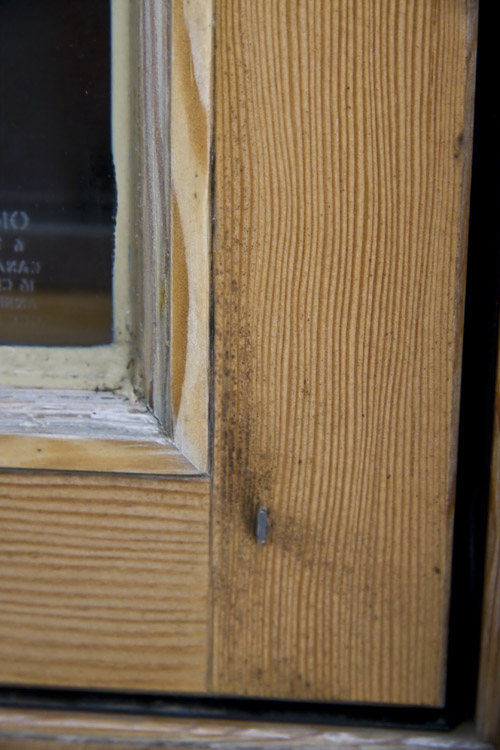
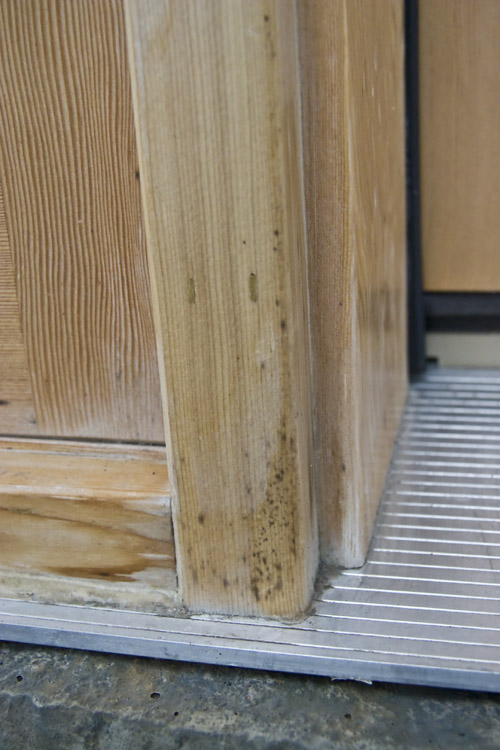
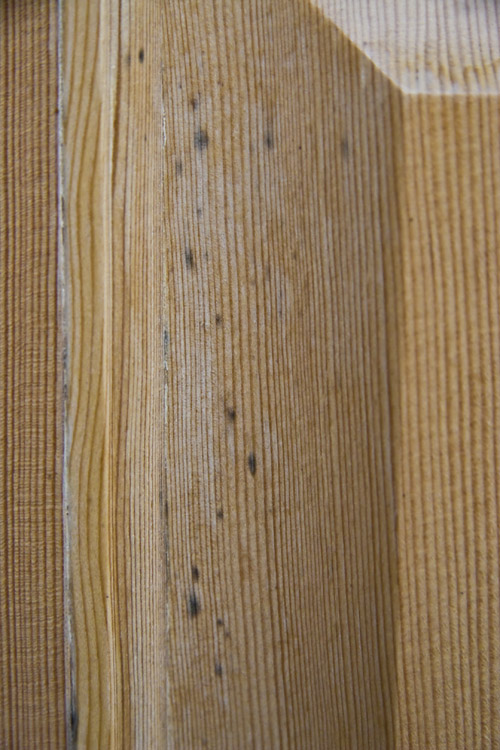
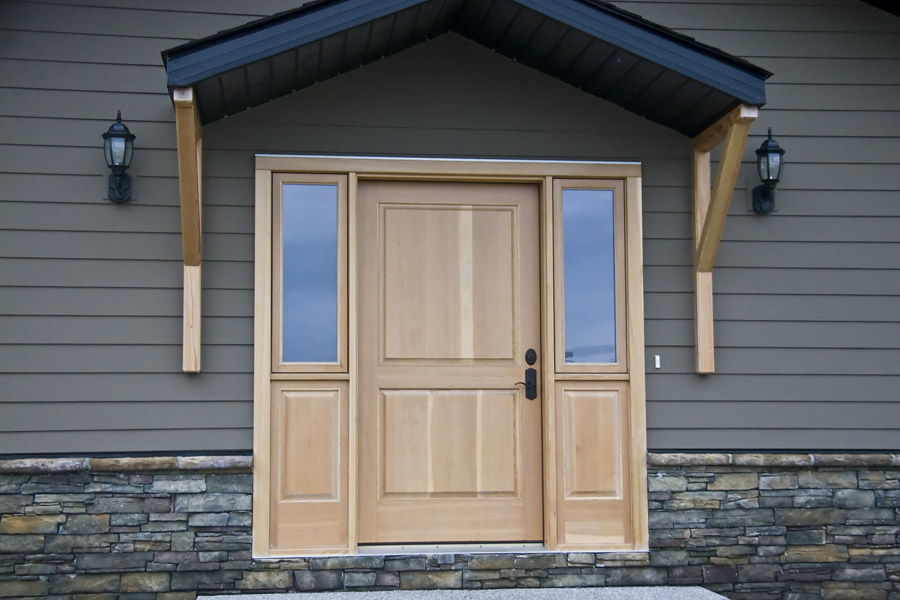
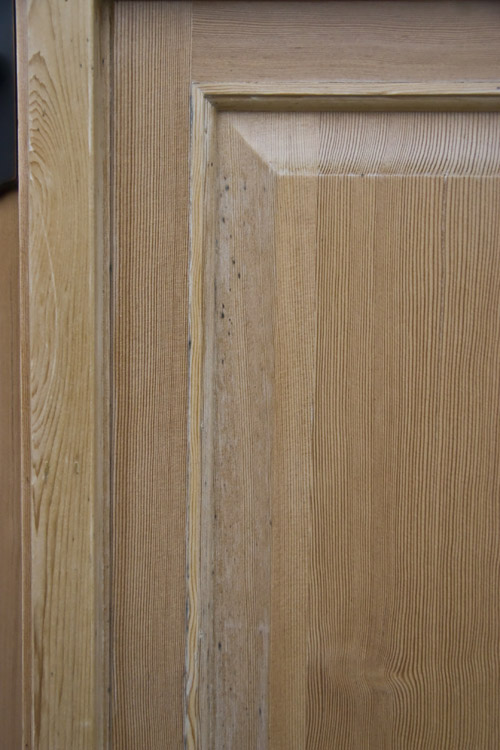
It looks like it gets a lot of direct sun also, Spar varnish will not hold up. I would use Sikkens Cetol1 and Cetol23. The first coat of Cetol1 must be brushed on then the second and third coats of Cetol23 can be brushed or sprayed. The beauty is you don't have to strip the door in a year just apply another coat.
The marine industry is a great place to research when moisture abatement is what your after. Problem you have is achieving a pleasing looking finishing without monster buildup, and discoloration after time. I recommend epoxy to stop moisture intrusion, then top-coat with something from the marine industry. Getting that end-grain or anywhere that wood meets metal to be water tight is going to be a chore, but you can fill the holes without any severe alterations to the overall look. Since it is such a soft wood, you may be able to get by with just a large syringe driven directly into the wood, but holes are better.
Comment from contributor S:
Fir doors have a lot of pitch in them. The newer versions of veneered fir doors even have more. What I have found is that when the door heats up and pitch comes through the surface and your finish, itís a perfect pathway for mold/bacteria to travel into your door and turn black. The black spots are underneath the clear finish and not superficial so bleaching is not effective. The pitch creates a perfect petri dish that the bacteria thrives in. These are not water stains. The problem with using a spar varnish is that eventually it will need to be stripped. The cost of stripping the door is cost preventative in most situations. If itís a veneered door itís most likely not possible and would need to be painted. Most door manufactures will guarantee the door against pitch coming out but not water going in. As soon as you see pitch and youíre within your warranty period (one year) call your supplier.